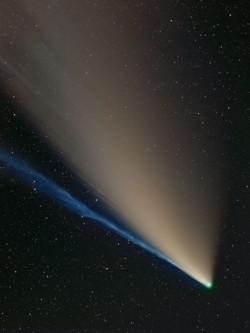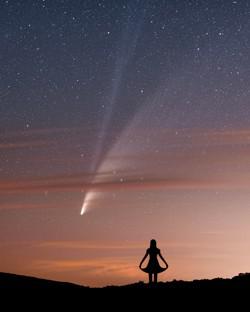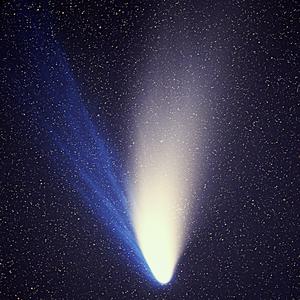Glossary term: Queue cométaire
Description: Lorsqu'une comète est proche du Soleil, le rayonnement solaire chauffe la surface de la comète. La glace à la surface se transforme en gaz (elle se "sublime"), entraînant avec elle des matériaux rocheux et poussiéreux. Le mélange résultant forme un nuage autour du noyau de la comète, appelé coma. En général, une comète a deux queues.
Les particules de poussière éjectées forment la première queue de la comète, qui a une forme courbe caractéristique. Elle est constituée de particules de poussière libérées de la surface, qui suivent la comète le long de son orbite autour du Soleil. Les queues de poussière peuvent mesurer des millions de kilomètres ou plus. Elles réfléchissent la lumière du Soleil et, si les conditions sont réunies, leur forme blanchâtre et diffuse explique la majeure partie de ce que l'on peut observer lorsqu'une comète est visible à l'œil nu.
Une partie importante du gaz est emportée et ionisée par le vent solaire, c'est-à-dire les particules chargées électriquement émises par le Soleil. Ces ions forment la seconde queue, ionique, de la comète, qui a généralement une couleur bleuâtre. La queue ionique est toujours orientée dans la direction opposée au Soleil. Si la comète elle-même s'éloigne du Soleil, la queue ionique la précède.
Related Terms:
See this term in other languages
Term and definition status: The original definition of this term in English have been approved by a research astronomer and a teacher The translation of this term and its definition is still awaiting approval
The OAE Multilingual Glossary is a project of the IAU Office of Astronomy for Education (OAE) in collaboration with the IAU Office of Astronomy Outreach (OAO). The terms and definitions were chosen, written and reviewed by a collective effort from the OAE, the OAE Centers and Nodes, the OAE National Astronomy Education Coordinators (NAECs) and other volunteers. You can find a full list of credits here. All glossary terms and their definitions are released under a Creative Commons CC BY-4.0 license and should be credited to "IAU OAE".
If you notice a factual or translation error in this glossary term or definition then please get in touch.
Related Media
Comet C/2020F3 (Neowise) with separate dust and ion gas tails and a green glowing coma, by Dietmar Gutermuth, Germany
Credit: Dietmar Gutermuth/IAU OAE
License: CC-BY-4.0 Creative Commons Attribution 4.0 International (CC BY 4.0) icons
Hello Comet, shall we dance?, by Robert Barsa, Slovakia
Credit: Robert Barsa/IAU OAE
License: CC-BY-4.0 Creative Commons Attribution 4.0 International (CC BY 4.0) icons
Comète Hale-Bopp
Credit: E. Kolmhofer, H. Raab ; Observatoire Johannes Kepler, Linz, Autriche credit link
License: CC-BY-SA-3.0 Creative Commons Attribution - Partage dans les Mêmes Conditions 3.0 non transposé icons











